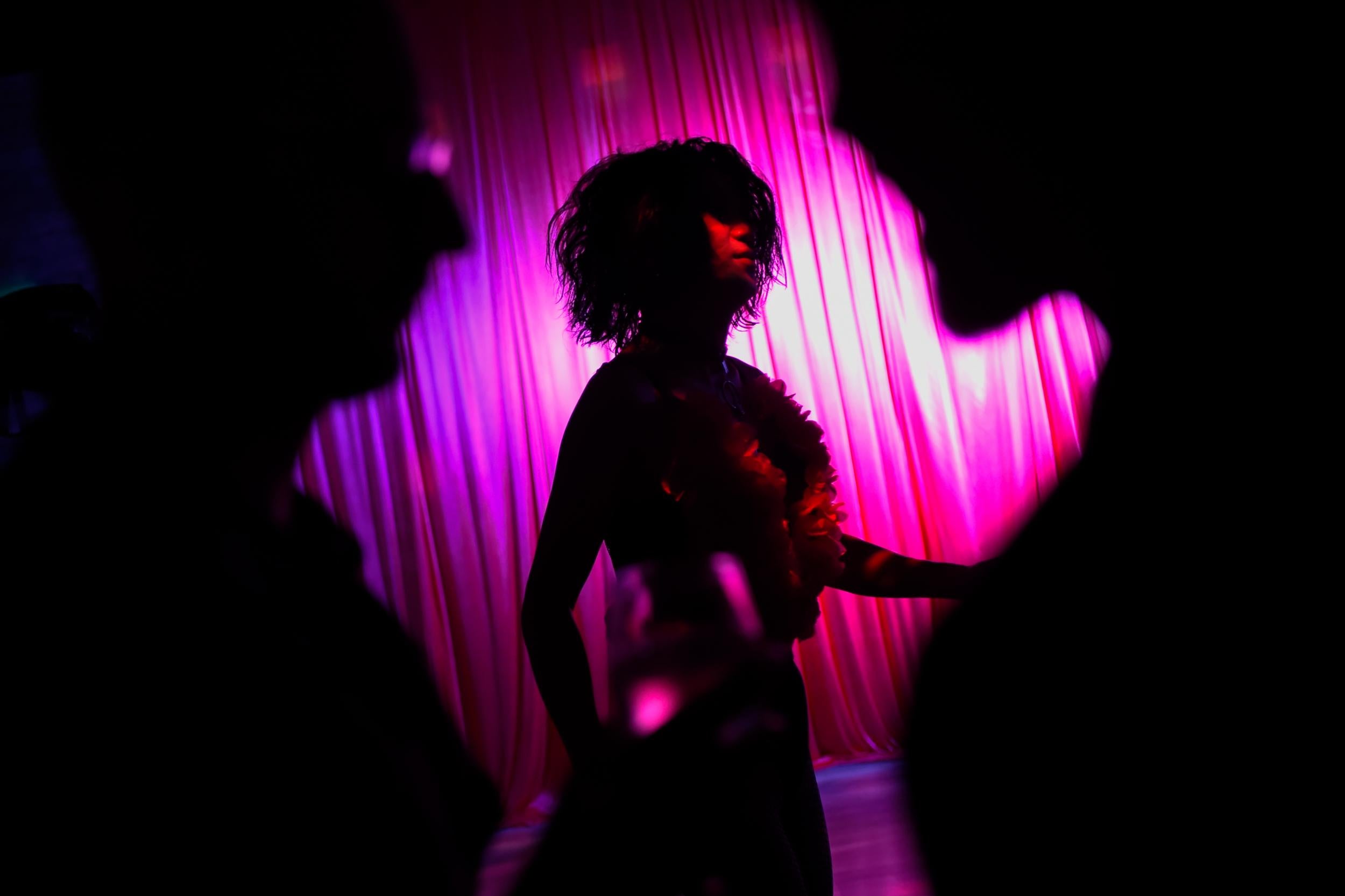Your support helps us to tell the story
From reproductive rights to climate change to Big Tech, The Independent is on the ground when the story is developing. Whether it's investigating the financials of Elon Musk's pro-Trump PAC or producing our latest documentary, 'The A Word', which shines a light on the American women fighting for reproductive rights, we know how important it is to parse out the facts from the messaging.
At such a critical moment in US history, we need reporters on the ground. Your donation allows us to keep sending journalists to speak to both sides of the story.
The Independent is trusted by Americans across the entire political spectrum. And unlike many other quality news outlets, we choose not to lock Americans out of our reporting and analysis with paywalls. We believe quality journalism should be available to everyone, paid for by those who can afford it.
Your support makes all the difference.With false eyelashes as long as her heels, Diamond was reading books to children in a library when she heard the hateful chant: “Drag queens are not for kids.”
A group of students from a conservative university group in Brisbane, Australia, had stormed the library and began shouting at Diamond, objecting to the drag queen’s involvement in children’s story time.
Bejewelled in a sequin rainbow dress and a feathered fascinator, Diamond and the protest group’s leader, Wilson Gavin, had a tense, heated exchange.
But the series of events that unfolded after last Sunday’s confrontation took an unexpected, tragic twist.
The video went viral, leading to much condemnation of the protest, which left many of the children in tears.
The following day, protest leader Wilson Gavin took his own life. He was 21 years old.
Australia has been left reeling over the heartbreaking incident. Many are saying it’s a story where nobody wins.
Another twist is that Wilson Gavin was an openly gay conservative. In the protest video, he tells Diamond to “sashay away” – lexicon borrowed from RuPaul’s Drag Race.
He publicly campaigned against marriage equality, appearing in a #VoteNo video during 2017’s postal vote on same-sex marriage in Australia.
In that video he said: “As a conservative you’re subjected to an unending barrage of vitriol, hatred and the nastiest comments imaginable.”
This week, right-wing broadsheet The Australian splashed with some of the Twitter comments about Wilson – including expletive insults and people who said he was an “oxygen thief” with a “hittable face” who made them feel “stabby”. One said he needed “schooling” and asked how he could meet him.
Processing such a complex story needs to be done with the utmost sensitivity. Many are keen to delicately understand the issues that led to the tragedy to see what lessons can be drawn – taking into account the dangers of cancel culture, trolling and homophobia.
Wilson’s suicide seems to be the extreme and tragic conclusion of an ever-polarised culture war.
“Where was the acceptance of others in this terrible story? Where was our consideration of each other’s humanity?” says cyberhate expert Ginger Gorman, author of bestselling book Troll Hunting.
“Their ambush of a rainbow storytelling event was horrifying. As a parent, I teach my children love and acceptance – and this was the opposite of that. However, the social media response to this video was vile. You can’t solve hatred with hatred.”
In her book, Ms Gorman writes about the “online disinhibition effect”, whereby people say online things they’d never say in real life – but stresses how those comments are strongly linked to real-life harms.
“Extreme cyberhate can certainly be a significant factor in a person’s decision to end their life – but usually it’s not the only one,” she tells The Independent. She describes a “triangulation” of factors that can lead to suicide. “We need to be careful of jumping to hasty conclusions without all the information about Wilson’s life and circumstances.”
Holly Zwalf runs Rainbow Families Queensland, which organised this drag storytime for kids aged two and over. The organisation has been hosting these events in Brisbane libraries for two years, inspired by the first drag queen storytime events that happened in San Francisco in 2015. They’ve led to similar protests by the American alt-right.
“When I heard news [about Wilson], I was absolutely devastated,” Ms Zwalf tells The Independent. “The LGBT+ community is at much higher risk of suicide; the reason we put on these events is to help raise people who are proud and strong in who they are.”
“It’s been a really tragic few days. Sunday’s protest deeply traumatised children and parents and made our community feel unsafe at a family-friendly event,” she says. “It marred a beautiful celebration of diversity.”
Literature from the protest group about drag queen story-time read: “What people do behind the closed doors of a nightclub is their business, but this event is designed to indoctrinate and sexualise young children.”
Ms Zwalf says Rainbow Families Queensland runs the events, where children’s books on LGBT+ themes are read to broaden the mind, not brainwash it: “It exposes young kids to ideas of fluidity in sexuality and gender,” she says. “It’s a great opportunity for kids to ask questions about things like boys wearing dresses. It introduces the playfulness of gender expression and identity.”
The young conservative group protested the name of Diamond, whose “stage name refers to a sexual act”.
Diamond’s performing name is Diamond Good-Rim.
“As with many performers, Diamond has both an adult and a child-appropriate persona,” Ms Zwalf says. “Diamond is only Diamond when she’s doing drag storytime.”
Drag queens are trained by a primary school teacher about age-appropriate clothing, language, behaviours and activities to ensure they’re fun and educational for kids.
A previous drag queen storytime in Wollongong, NSW, was targeted by online protests, leading to extra security but no incident on the day. “The drag queen hosting that event was nervous about her safety,” Ms Zwalf says.
Anna Brown of Equality Australia, along with everyone interviewed here, expressed deepest condolences at Wilson’s death. “While others who knew him better can make personal tributes and reflections, Wilson was a proud conservative, and at times opposed the work we do and the stances we take,” says the CEO of the lobbying organisation that protects and promotes LGBT+ rights.
“Yet we recognise him as a member of our LGBTIQ+ community. And we recognise that hurt people can hurt people,” she says, citing disproportionately higher suicides and mental health conditions among LGBT+ people. “The intolerance they see around them makes them feel worthless.”
She described LGBT+ suicide as “a national crisis demanding more attention”.
The distraught organiser of Birsbane’s drag queen storytime, Ms Zwalf, turned her phone off yesterday to process the trauma of this story where nobody wins.
She thinks for some time before summing up her feelings on the whole tragic episode.
“I feel deeply regretful he didn’t himself believe that all gay people like him deserve equality.”
If you are struggling and need to talk, the Samaritans operate a free helpline open 24/7 on 116 123. Alternatively you can email jo@samaritans.org or visit their site to find your local branch
If you are based in Australia, you also call Lifeline on 13 11 14


Join our commenting forum
Join thought-provoking conversations, follow other Independent readers and see their replies
Comments